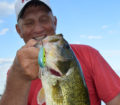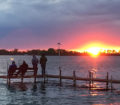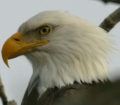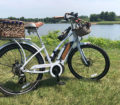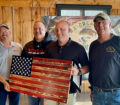By Jason Mitchell
Editor’s note: Watch Jason Mitchell Outdoors on Fox Sports North every Sunday at 9 a.m. Find out more information at www.jasonmitchelloutdoors.com.

(photo submitted) Jerk baits like the Salmo Rattling Sting compliment live bait. Find fish faster with suspending hard baits and soft plastics. Switch over to live bait when you wear out your welcome.
That late spring period is a coveted time for walleye anglers. More specifically, the post spawn time frame often creates great windows of opportunity. While each fishery can have a different personality and the nuances can vary, we have found some universal concepts that do seem to be applicable just about everywhere we fish.
Below are some hard-earned insights from our team that have not only narrowed our focus but also kept us on track. We often joke with fishing that we can never say “never” or “always” as there is always an exception, but the follow list is something to consider.
- Watch your temperature gauge. Early in the season when water temperatures are still on the cool side, finding the warmer or warmest water often means finding fish. Particularly during stable warming trends after the fish have spawned, we often find more fish using shallow water and the best shallow water is often the warmest. You will find fish on other locations but the locations that have the warmest water almost always hold fish.
- Trust and Incorporate Side Imaging. Because fish can often be shallow or high in the water column early in the year (especially when the sun comes out), you won’t often see fish below the boat on traditional sonar. Where you can see fish however is with side scan or side imaging. I personally use a Lowrance HDS Carbon that I really like for showing fish. If you are first learning how to interpret what is on the screen, move the boat at a faster speed than the speed you would typically fish so that you get a more defined picture. An optimum speed is often around three miles per hour. Fish will often look bright and look like a stretched-out piece of rice with a shadow next to the mark. The shape of the fish can get distorted based on your speed and how the fish or boat is moving.
- Drink the Cool Aid. Colder water that hasn’t been mixed up by wind is often very clear. On many fisheries, the water will stain up as it begins to warm. You can often quickly identify the best areas by how the water looks. You are not necessary looking for turbid or dirty water that has been churned up by wind but rather just a nice stain in the water that you can still see through. A good color will resemble cool aid. When the water really clears up, spend the time to look for that water with the stain. That stained water will often coincide with water temperature.
- Be Patient in the Morning. What we see so often when the water temperatures really cool off at night is that it takes a little while for some spots to get going. We so often find that we struggle to scratch a few fish in the morning, but the bite keeps getting better as the water temperatures warm through the day. If I were to pick a prime-time day in and day out, early afternoon would be tops so don’t give up on good spots too early in the day.
- When to Follow the Wind. Fishing the wind is so crucial on many fisheries. Wind will distort light penetration, hide your presence and stack warm water into a location. Heat combined ith wind is often a sure bet combination that produces fish.
- When Not to Follow the Wind. Knowing when to avoid the wind can be just as important. Excessive winds that start to muddy the water to a point where the water becomes extremely turbid can often be something to avoid. When wind creates enough of a current to suck up colder water from deeper or more expansive sections of a lake and then pushes that colder water onto the location you are fishing, simply avoid it. Wind is good until the water temperatures start to drop. Therefore, the calm or protected locations can often fish better in extreme weather.
- Deep is an Option. Most of this list so far is geared towards active fish in shallow water but there are times when the shallows are devoid of life. If the season feels really behind schedule or if you are dealing with the after effects of massive fronts that crashed water temperatures, fast forward to channels and deeper structure. Most of the time, these locations can still be shoreline related but you will also see fish pile up onto deep offshore locations in the most extreme weather or conditions. Remember as well that both shallow and deep are relative. There are some fisheries where shallow is ten to fifteen feet while that would be considered deep on other bodies of water. Each fishery will be unique.
- Slow and Slower. We catch fish with a lot of different presentations early in the season, but we often find that we need to slow down to catch fish. Not just the actual boat speed or lure speed but slowdown in how we fish where we catch more fish by being methodical. You can miss fish so easily by simply working too fast. You must find the fish and cover water but force yourself to slow down when everything feels right. We often find that we start to catch fish when we slow down and catch even more when we slow down even more. There are a few exceptions however. If you are fishing sand grass and low-lying weeds and you keep bogging down in the vegetation with a jig for example, pick up your speed and lighten your jig so you can glide and hang above it.
- Cast More. There are still many areas where most of the walleye fishing is done by dragging jigs or rigs below or behind the boat. That no doubt works and should remain in your tool box but make a point to fan cast more this spring. You will be amazed how many days where you simply catch so many more fish.
- Two Punch. We often catch fish early in the season with soft plastics and jerk baits. These artificial options can be worked a touch faster to cover more water. When you wear out your welcome with the artificial options, come back through with live bait. A jig with a soft plastic truly compliments a jig with a minnow. Incorporate both into your arsenal and get confident with both. This one, two, punch will elevate your game dramatically.

